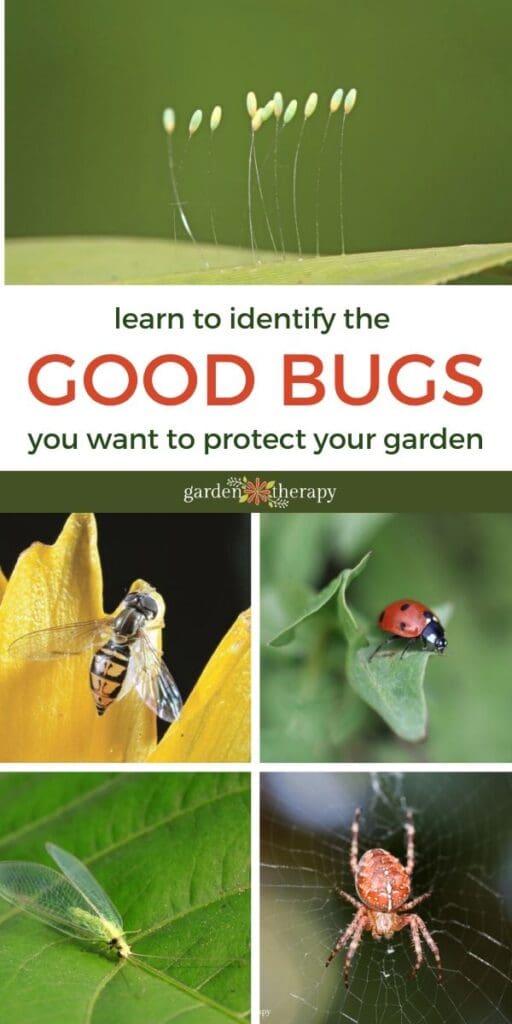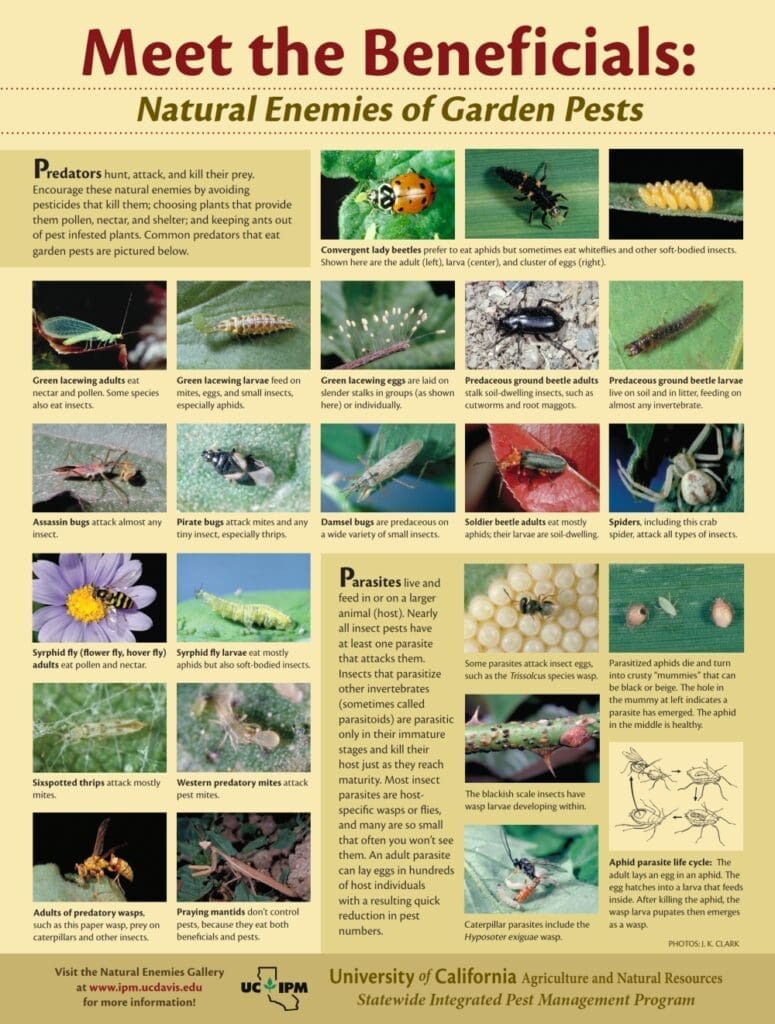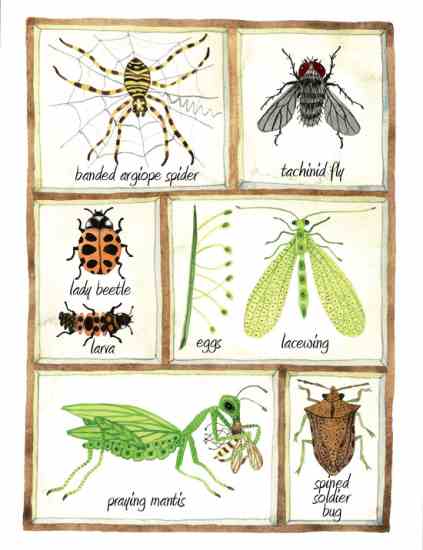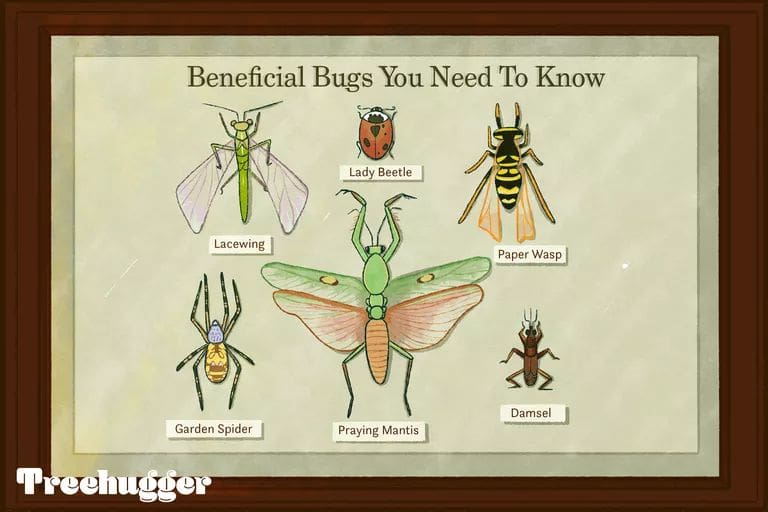Imagine stepping into your garden and being greeted by a multitude of colorful flowers, healthy plants, and thriving crops. How did this transformation occur? The secret lies in the presence of beneficial insects. These unsung heroes play a vital role in maintaining the ecological balance in your garden, ensuring the health and productivity of your plants while naturally controlling pests. From ladybugs to lacewings, these tiny creatures are the key to a flourishing garden. In this article, we will explore the fascinating world of beneficial insects and their invaluable contributions to your garden’s ecosystem. Get ready to discover the secret allies that can turn your garden into a thriving oasis.

Introduction
Gardening can be a rewarding and fulfilling hobby, but it also comes with its fair share of challenges. Dealing with pests and maintaining a healthy ecosystem within your garden can sometimes feel like an uphill battle. However, there is a secret weapon that can help you in your quest for a thriving garden – beneficial insects. These tiny heroes play a crucial role in natural pest control, promote ecosystem balance, and improve soil health. By attracting and protecting these beneficial insects, you can create a harmonious environment in your garden that will lead to healthier plants and a more vibrant ecosystem.
Importance of Beneficial Insects
Natural pest control
One of the key roles that beneficial insects play in your garden is natural pest control. Instead of relying on harmful chemical pesticides, you can harness the power of these natural predators to keep pesky pests in check. Beneficial insects such as ladybugs, parasitic wasps, and ground beetles are voracious predators of common garden pests like aphids, caterpillars, and beetles. By introducing these helpful insects into your garden, you can reduce the need for chemical pesticides and maintain a healthier balance between pests and their natural enemies.
Ecosystem balance
A healthy garden ecosystem relies on a delicate balance between various organisms. Beneficial insects play a vital role in maintaining this balance by preying on harmful pests and preventing their populations from exploding. Without these natural predators, pest populations can quickly spiral out of control, leading to widespread damage to your plants. By cultivating a diverse population of beneficial insects, you are creating a self-sustaining ecosystem that can naturally regulate pest populations and ensure the long-term health of your garden.
Promoting pollination
In addition to their pest control abilities, many beneficial insects are also crucial pollinators. Bees, hoverflies, and other pollinator insects play a critical role in fertilizing flowers and ensuring the reproduction of many plants. Without these pollinators, the production of fruits, vegetables, and seeds would be severely impacted. By attracting beneficial insects to your garden, you are not only protecting your plants from pests but also ensuring their reproductive success and the abundance of your harvest.
Improving soil health
Beneficial insects can also contribute to improving the health of your garden soil. Ground beetles, for example, help by feeding on weed seeds and other pests that can compete with your plants for nutrients. Their activity aerates the soil and helps break down organic matter, releasing nutrients that are essential for plant growth. Additionally, the excrement left behind by beneficial insects, known as frass, can act as a natural fertilizer, enriching the soil and promoting microbial activity. By attracting and supporting a diverse population of beneficial insects, you are creating a healthy and fertile environment for your plants to thrive.
Common Beneficial Insects
Ladybugs
One of the most well-known beneficial insects is the ladybug, or ladybird beetle. These small, colorful insects are voracious predators of aphids, scale insects, and other soft-bodied pests. Ladybugs can consume hundreds of aphids in a single day, making them a valuable asset in any garden. You can attract ladybugs to your garden by planting pollen and nectar-rich flowers such as daisies, cosmos, and yarrow. Ladybugs can also be purchased and released in your garden to jumpstart their population.
Bees
Bees are not only essential pollinators but also valuable beneficial insects. They play a vital role in pollinating a wide variety of flowering plants, including many fruits, vegetables, and ornamental flowers. By providing a diverse range of flowering plants that bloom throughout the growing season, you can attract and support a healthy population of bees in your garden. Avoid the use of chemical pesticides, as they can be harmful to these important pollinators.
Hoverflies
Hoverflies, also known as flower flies, resemble bees or wasps but are harmless to humans. These insects are important pollinators and active predators of aphids and other small insects. Hoverflies can be attracted to your garden by planting flowers such as asters, zinnias, and goldenrod. By including plants with small, shallow flowers, you can provide a nectar source for adult hoverflies, while also creating an environment that encourages them to lay their eggs near aphid-infested plants.
Parasitic wasps
Despite their name, parasitic wasps are not harmful to humans. These tiny wasps lay their eggs on or inside the bodies of other insects, such as aphids, caterpillars, and whiteflies. The wasp larvae then develop by consuming the host insect, effectively controlling its population. To attract parasitic wasps to your garden, you can provide a mix of flowering plants to attract the adult wasps, as well as specific host plants for their larvae. For example, planting dill, fennel, or parsley can attract parasitic wasps that target caterpillar pests.
Ground beetles
Ground beetles are nocturnal predators that feed on a wide range of pests, including slugs, snails, and cutworms. These beetles are typically dark-colored and have long legs, which enable them to move swiftly and capture their prey. To attract ground beetles to your garden, create sheltered areas such as rock piles, logs, and ground cover plants. Ground beetles require hiding places during the day, and these shelters will encourage them to take up residence in your garden and patrol for pests during the night.
Attracting Beneficial Insects
Planting diverse flowers
One way to attract beneficial insects to your garden is by planting a diverse selection of flowers. Different beneficial insects are attracted to different types of flowers, so having a variety of plants will increase your chances of attracting a wide range of beneficial species. Choose flowers that bloom at different times throughout the growing season to provide nectar and pollen sources for beneficial insects year-round. Some good choices include coneflowers, sunflowers, lavender, and daisies.
Providing water sources
In addition to food sources, beneficial insects also need access to water for survival. Providing a water source in your garden, such as a shallow dish filled with water and pebbles, can attract and support beneficial insects. Make sure to clean and refill the water source regularly to prevent the growth of mosquitoes or other pests. Water sources can also create a valuable habitat for frogs, toads, and other beneficial organisms that can contribute to overall garden health.
Creating habitat diversity
Beneficial insects require diverse habitats to thrive. By creating a variety of different habitats in your garden, you can attract and support a wide range of beneficial species. Incorporate features such as flowering plants, shrubs, trees, and even a small pond or bird bath. Providing different levels of vegetation and offering a mix of sunny and shaded areas will ensure that you attract a diverse population of beneficial insects that can meet all their needs.
Avoiding pesticide use
Chemical pesticides can be harmful to beneficial insects, as they can kill both the pests and the natural predators that keep them in check. Whenever possible, avoid the use of chemical pesticides in your garden and opt for organic pest control methods instead. By using methods such as handpicking pests, introducing beneficial insects, and practicing cultural control techniques, you can effectively manage pests without harming the beneficial organisms that contribute to your garden’s health.
Using cover crops
Cover crops are specific types of plants that are grown to protect and improve the soil during periods when the main crops are not growing. They can also help attract beneficial insects to your garden. Cover crops such as clover, buckwheat, and vetch provide valuable sources of nectar and pollen for beneficial insects. Additionally, cover crops can improve soil fertility, suppress weeds, and prevent soil erosion, making them a beneficial addition to any garden.

Using Companion Plants
Marigolds
Marigolds are not only beautiful flowers but also effective companion plants in the garden. They release a strong fragrance that can deter a wide range of pests, including whiteflies, nematodes, and aphids. Marigolds also attract beneficial insects such as ladybugs and hoverflies. Plant marigolds around susceptible plants or throughout your garden to create a natural barrier against pests and encourage the presence of beneficial insects.
Alyssum
Alyssum is a low-growing flowering plant that is commonly used as a ground cover or in container gardens. It produces clusters of small, fragrant flowers that attract beneficial insects such as hoverflies and parasitic wasps. Alyssum also acts as a natural mulch, helping to retain soil moisture and suppress weed growth. Planting alyssum near vegetable crops or among ornamental plants can provide a valuable food and shelter source for beneficial insects.
Dill
Dill is an aromatic herb that not only enhances the flavor of your dishes but also attracts beneficial insects. The feathery foliage of dill attracts beneficial insects such as ladybugs, hoverflies, and parasitic wasps. These insects are attracted to dill because it provides them with a reliable source of food and a suitable habitat for shelter and reproduction. Incorporating dill into your garden will not only benefit your culinary pursuits but also contribute to the health and vitality of your garden ecosystem.
Nasturtiums
Nasturtiums are vibrant, colorful flowers that can add a splash of beauty to your garden while also attracting beneficial insects. The flowers of nasturtiums produce nectar that attracts hoverflies, ladybugs, and other beneficial insects. These insects, in turn, help to control pests such as aphids and caterpillars. Nasturtiums are also edible and can be a tasty addition to salads or used as a garnish, providing you with a dual-purpose plant for your garden.
Borage
Borage is a versatile herb with beautiful blue-purple flowers that are known for their strong nectar production. These flowers attract bees, hoverflies, and other beneficial insects that can help control garden pests. Borage is also an excellent companion plant for many vegetable crops, as it helps repel pests and improves the health of the surrounding plants. Additionally, borage leaves and flowers are edible and can be used in salads, teas, or as a garnish, making it a useful and attractive addition to any garden.
Beneficial Insects and Pest Management
Targeting specific pests
One of the advantages of using beneficial insects for pest management is their ability to specifically target certain pests. Different beneficial insects have preferences for certain types of pests or stages of the pest’s life cycle. For example, parasitic wasps are highly effective at controlling caterpillar pests, while ladybugs prey on aphids. By identifying the specific pest problems in your garden, you can choose the appropriate beneficial insects to introduce or attract, effectively targeting and managing those pests without harming the entire ecosystem.
Reducing chemical pesticide use
One of the main benefits of utilizing beneficial insects in your garden is the reduced reliance on chemical pesticides. Chemical pesticides can have detrimental effects not only on pests but also on beneficial insects, as well as other organisms in the garden. By incorporating beneficial insects into your pest management strategy, you can greatly reduce or even eliminate the need for chemical pesticides. This not only benefits the overall health of your garden but also contributes to a safer and more sustainable environment.
Integrated Pest Management (IPM) approach
Using beneficial insects in your garden is a key component of an Integrated Pest Management (IPM) approach. IPM is a holistic and environmentally friendly approach to pest control that focuses on long-term prevention and minimizing the use of harmful pesticides. By combining multiple methods such as cultural control techniques, biological control, and regular monitoring, you can effectively manage pests while minimizing the impact on beneficial insects and other garden organisms. Beneficial insects are a vital tool in the IPM toolbox and can be an integral part of a successful pest management strategy.
Timing the release of beneficial insects
To maximize the effectiveness of beneficial insects, it’s important to time their release correctly. Many beneficial insects, such as ladybugs and parasitic wasps, are available for purchase and can be introduced into your garden. However, it’s essential to release them when the target pests are present and vulnerable. For example, if you have a problem with aphids, release ladybugs when the aphids are actively feeding and the temperature is suitable for their survival. Timing the release of beneficial insects ensures that they have a ready food source and increases the likelihood of successful pest control.

Identifying and Monitoring Beneficial Insects
Visual identification
One of the simplest ways to identify beneficial insects in your garden is through visual observation. Take the time to observe the insects that visit your garden, paying attention to their physical characteristics and behaviors. Many beneficial insects have distinct features that can help with identification. Ladybugs, for example, are usually small, rounded beetles with brightly colored shells. Hoverflies, on the other hand, mimic bees or wasps but lack stingers. By familiarizing yourself with the appearance of beneficial insects, you can quickly identify them and appreciate their presence in your garden.
Use of sticky traps
Sticky traps can be a useful tool for monitoring the population levels of beneficial insects in your garden. These traps consist of adhesive surfaces that catch insects when they come into contact with the trap. By strategically placing sticky traps throughout your garden, you can get an idea of the types and numbers of insects present. However, it’s important to use sticky traps sparingly and only as a monitoring tool, as they can also inadvertently trap and harm beneficial insects.
Beneficial insect identification apps
Thanks to modern technology, identifying beneficial insects has become easier than ever. There are several smartphone apps available that can help you identify the insects in your garden. These apps typically use image recognition software and extensive databases to provide accurate identifications. Simply take a photo of the insect in question and let the app do the rest. Beneficial insect identification apps can be a valuable resource for both novice and experienced gardeners, helping to expand your knowledge and understanding of the diverse array of insects that inhabit your garden.
Monitoring population levels
Regular monitoring of beneficial insect populations is essential for effective pest management. Keep an eye on the numbers and diversity of beneficial insects in your garden to ensure they are present in sufficient numbers to control pests. If you notice a decline or absence of certain beneficial insects, it may be an indication of an imbalance in your garden ecosystem. In this case, take steps to attract or reintroduce the missing beneficial insects. By monitoring the population levels of these helpful garden allies, you can make informed decisions to support their presence and maintain a healthy garden environment.
Protecting Beneficial Insects
Avoiding broad-spectrum insecticides
One of the most important ways to protect beneficial insects in your garden is by avoiding the use of broad-spectrum insecticides. Broad-spectrum insecticides are designed to kill a wide range of insects, both harmful and beneficial. Instead, opt for selective insecticides that target specific pests while minimizing harm to beneficial insects. If pesticide use is necessary, choose products that are labeled as safe for beneficial insects and follow the instructions carefully to minimize any negative impact on the environment.
Using organic gardening practices
Embracing organic gardening practices is another way to protect beneficial insects in your garden. Organic gardening avoids synthetic fertilizers and pesticides, relying instead on natural and sustainable methods. By implementing organic practices such as composting, crop rotation, and using natural pest control methods, you can create an environment that supports beneficial insects and promotes overall garden health. Organic gardening not only benefits your plants and beneficial insects but also contributes to a safer and healthier environment for you and your family.
Providing shelter and nesting sites
Beneficial insects need suitable habitats to thrive and reproduce. By providing shelter and nesting sites, you can encourage the establishment and persistence of beneficial insect populations in your garden. Leave areas of your garden undisturbed, such as piles of rocks or logs, to create hiding places for insects. Incorporate native plants and grasses that provide shelter for beneficial insects. By diversifying the structure and composition of your garden, you are providing a range of options for beneficial insects to find suitable nesting and overwintering sites.
Creating wildlife-friendly garden spaces
Creating a wildlife-friendly garden space is not only beneficial for beneficial insects but also for a wide range of other organisms. Encourage biodiversity by incorporating elements such as birdhouses, bat boxes, or insect hotels into your garden. These features provide nesting opportunities for beneficial insects and attract other wildlife that can contribute to pest control, such as birds and bats. By creating a welcoming and diverse habitat, you are fostering a balanced and sustainable garden ecosystem that benefits all its inhabitants.

Common Harmful Insects in Gardens
Aphids
Aphids are small, soft-bodied insects that feed on the sap of plants. They reproduce rapidly and can quickly infest a plant, causing stunted growth and distortion of leaves and stems. Aphids are known to excrete a sticky substance called honeydew, which can attract other pests and promote the growth of black sooty mold. Fortunately, beneficial insects such as ladybugs, lacewings, and parasitic wasps feed on aphids and can help control their populations.
Cabbage worms
Cabbage worms are the larvae of butterflies and moths, including the familiar cabbage white butterfly. These voracious pests feed on members of the cabbage family, including broccoli, cauliflower, and kale. Cabbage worms can cause severe damage to these crops, defoliating them and reducing yields. To control cabbage worms, introduce beneficial insects such as parasitic wasps or practice physical barriers, such as covering the plants with row covers, to prevent egg-laying by the adult butterflies.
Spider mites
Spider mites are tiny pests that feed on plants by piercing the cells and sucking out the sap. They are particularly problematic in hot and dry conditions, where their populations can explode rapidly. Spider mite infestations often lead to yellowing, bronzing, and wilting of leaves, as well as the presence of fine webbing. To manage spider mites, introduce predatory mites or use high-pressure water sprays to physically dislodge and control their populations.
Mealybugs
Mealybugs are soft-bodied pests covered in a cottony white or waxy substance. They often congregate on the undersides of leaves and in leaf axils, sucking sap and excreting honeydew. Mealybugs can weaken plants and promote the growth of sooty mold. To control mealybugs, introduce beneficial insects such as ladybugs or lacewings, or use horticultural oils to smother and suffocate the pests.
Whiteflies
Whiteflies are small, flying insects that can quickly infest plants, especially those grown in greenhouses or indoor settings. They feed on plant sap and excrete honeydew, causing wilting, stunted growth, and the development of black sooty mold. To manage whiteflies, introduce beneficial insects such as parasitic wasps or use yellow sticky traps to monitor and control their populations.
Conclusion
Beneficial insects are indispensable allies in the quest for a healthy and thriving garden. Their natural pest control abilities, role in promoting ecosystem balance, and contributions to pollination and soil health make them an invaluable asset to any gardener. By attracting and protecting beneficial insects, you can reduce the need for harmful chemical pesticides, support a vibrant garden ecosystem, and enjoy the beauty and abundance of a well-balanced garden. So, embrace the power of beneficial insects and create a haven for these tiny heroes in your garden. Your plants, the environment, and future generations will thank you for it.


I am Randy, the author behind PestControld.com. Drawing from decades of experience, I aim to provide valuable insights, expert advice, and practical recommendations to help you make informed decisions when assessing viable pest control solutions.